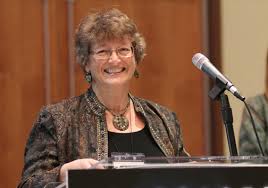A different way of meeting God

The Bible: Wisdom Literature
Jewish Family Education with Candace R. Kwiatek, The Dayton Jewish Observer
Everywhere in the world it’s becoming commonplace to encounter entrance barricades, locked doors, surveillance cameras, and security officers at synagogues, JCCs, schools, and other Jewish facilities.
Sadly, the danger is ubiquitous, even in the United States, as we learned from the horrific Pittsburgh synagogue shooting on Oct. 27.
The reality of antisemitism in America is familiar to older Jews. Immigration and university quotas. Housing and job discrimination. Restaurant, hotel, and club exclusion. Slurs such as Hymie, kike, sheeny, Shylock, Christ killer, and oven dodger. Perceptions of Jews as the greatest threat to American welfare. Synagogue bombings and arson attacks. Neo-Nazis and the Ku Klux Klan. Holocaust denial.
However, the experience of younger Jews is radically different “because today in America, Jew-loving is a bit of a craze,” observe Microtrends authors Mark Penn and Kinney Zalesne. “Jews are in demand everywhere. Whatever in the past seemed to trigger envy or rejection of Jews now seems to be triggering admiration and attraction.”
In fact, they note that in a 2006 Gallup poll, public opinion rated Jews the highest of any religious or spiritual group in the U.S. So, “for the younger, college-aged kids, the shock (of Pittsburgh) is more along the lines of, how can people hate me this much?” observes Rabbi Shlomo Agishtein.
Conventional wisdom is that Jew-hatred is as old as the Jewish people, “a long unbroken line of antisemitism, from Pharaoh and Nebuchadnezzar to Hitler and Arafat” in the words of Israeli journalist and author Amos Elon.
However, Prof. Rabbi Martin Lockshin notes that “the Bible rarely depicts gentile hatred of or animus toward Jews simply because they were Jews.”
He maintains that only in Esther, one of the latest biblical books, do we find authentic antisemitism.
In this operatic tale, Queen Esther and her uncle Mordechai save the Jewish people of Persia from annihilation by King Ahashverus’ evil chief minister, Haman, who misrepresents the character of the Jews: “There is a certain people, scattered and dispersed among the other peoples in all the provinces of your realm, whose laws are different from those of any other people and who do not obey the king’s laws (Esther 3:8).” Hostility, prejudice, and discrimination specifically targeted toward Jews: antisemitism in a nutshell.
Historically speaking, anti-Jewish sentiment first appears in Hellenistic writings in the third century B.C.E. and soon escalates to physical attacks and anti-Jewish edicts, note historians Edward Flannery and David McClister.
The trend is endless, the Passover Haggadah laments, “Not only one arose and tried to destroy us, rather in each and every generation they rise up against us to destroy us.” But why?

In his Haggadah commentary, Rabbi Lord Jonathan Sacks describes this phenomenon best: “Antisemitism is not…a coherent belief or ideology. Jews have been hated because they were rich and because they were poor; because they were capitalists and because they were communists; because they believed in tradition and because they were rootless cosmopolitans; because they kept to themselves and because they penetrated everywhere. Antisemitism is not a belief but a virus… (and it) mutates.”
Although the Bible acknowledges this human tendency to marginalize those who are different, it cautions against such prejudice and bigotry in the interest of creating good people and societies.
Only once does the Bible command us to love our neighbor, Sacks observes, “but in 37 places it commands us to love the stranger. Our neighbor is one we love because he is like ourselves. The stranger is one we are taught to love precisely because he is not like ourselves.”
How we are to treat the stranger is partially founded in empathy. “You shall not wrong the stranger, nor shall you oppress him; for you were strangers in the land of Egypt (Ex. 22:20).”
Empathetic treatment includes, at the very least, respecting their rights: Sabbath rest, a fair wage, access to unbiased justice, opportunity to glean from the fields, being welcome in our communities, and sanctuary as an escaped slave.
Biblical guidance about human interaction is also founded in kinship and Divine likeness. All humans are descendants of a single human, and all are made in the image of God (Gen. 1:27).
But biblical stories teach the most important concept: we are to judge people based on their character alone, not race, religion, or ethnicity.
Abraham, a pagan Aramean from Ur, becomes the father of the Jewish people.
Rahab, the Canaanite prostitute who hid the Israelite spies in Jericho, is welcomed among the Israelites.
Jethro, Moses’ Midianite father-in-law who offers sage leadership advice, is honored with his own Torah portion.
Ruth, the Moabite who cares for her widowed Israelite mother-in-law and joins the Israelites herself, becomes the great-grandmother of King David.
Perceiving the stranger as an other — something alien to be marginalized and ultimately excluded — “is a profound human failure to accept the fact that we are diverse and must create space for diversity if we are to preserve our humanity,” Sacks cautions.
After all, just as God is the source of our kinship and Divine nature, God is also the creator of our human differences.
“Therefore,” Sacks concludes, “it is in one-who-is-different that we meet God.”
Literature to share
Gateway to the Moon by Mary Morris. Historical fiction at its most engaging, Morris’ novel weaves together the voyages of Columbus, the Inquisition and Expulsion, and the relocation of many Spanish Jews to South America and eventually the American southwest. Five hundred years later, a young amateur astronomer there begins to unravel the history of the region and his own story. This memorable saga is a fascinating retelling of two eras of Jewish history and a testimony to the resilience of the Jewish people.
This is Just a Test by Wendy Wan-Long Shang. Set in the 1980s, Shang’s novel is a humorous reflection on middle-school life, from threats of nuclear annihilation and clothing styles to Bar Mitzvah preparations and family relationships. Woven throughout is the notion of identity, cleverly brought to life by the Bar Mitzvah’s grandmothers, one Chinese and one Jewish. It’s a fun tale with a good message that will resonate with pre-teens and their parents.
To read the complete December 2018 Dayton Jewish Observer, click here.



